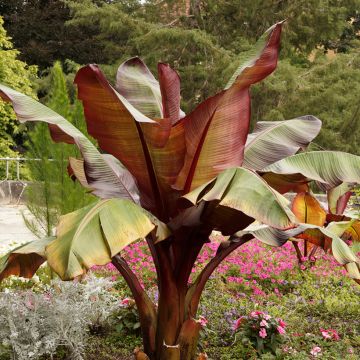

Escallonia rubra Crimson Spire


Escallonia rubra Crimson Spire


Escallonia rubra Crimson Spire
Escallonia rubra Crimson Spire
Escallonia rubra var. Macrantha Crimson Spire
Redclaws, Chilean Gum Box
Impeccable packaging, but.... 2 broken branches due to the packaging being forced into a box that was too small, leaves stained yellow and black like the roses, no root ball, just a tangle of roots forming a dried-up mat; the response from "Matthieu": No problem, the young plant will recover. I have many doubts about this, I do not recommend your site.
Geneviève, 08/05/2024
Special offer!
Receive a €20 voucher for any order over €90 (excluding delivery costs, credit notes, and plastic-free options)!
1- Add your favorite plants to your cart.
2- Once you have reached €90, confirm your order (you can even choose the delivery date!).
3- As soon as your order is shipped, you will receive an email containing your voucher code, valid for 3 months (90 days).
Your voucher is unique and can only be used once, for any order with a minimum value of €20, excluding delivery costs.
Can be combined with other current offers, non-divisible and non-refundable.
Home or relay delivery (depending on size and destination)
Schedule delivery date,
and select date in basket
This plant carries a 24 months recovery warranty
More information
We guarantee the quality of our plants for a full growing cycle, and will replace at our expense any plant that fails to recover under normal climatic and planting conditions.
Would this plant suit my garden?
Set up your Plantfit profile →
Description
The 'Crimson Spire' Escallonia is an excellent evergreen bush, whether left untrimmed or pruned. Vigorous and fast-growing, it has an upright habit that can be kept dense through pruning and boasts a long summer flowering period with small tubular flowers of vibrant purple-pink. This striking colour is complemented by its fragrant foliage, which is a beautiful dark green. It is a must-have in coastal gardens as it thrives in full sun, tolerates partial shade in hot climates, and withstands salt spray, slightly chalky soils, and summer drought once established. Its only weakness is its moderate hardiness, as it struggles when temperatures drop below -10°C (14 °F).
The 'Crimson Spire' Escallonia is a horticultural cultivar derived from the Chilean species Escallonia rubra, which is extensively used by horticulturists due to its highly variable habit, foliage, and natural flowering. The Macrantha form distinguishes itself from the typical form with its vigour and large leaves, while the 'Crimson Spire' cultivar displays a particularly upright habit. All these plants belong to the Escalloniaceae family. Botanical escallonias are native to temperate zones of South America and Chile. In the wild, these shrubs grow among the scrub covering hillsides or on exposed coastal areas.
The 'Crimson Spire' variety naturally forms a sparsely branched bush with an erect habit. Its long, flexible, and woody climbing stems tend to arch over time. To promote denser growth and maintain an attractive habit, it is necessary to prune the bush quite short, once a year. This variety will quickly reach an average height of 1.50m (4 ft 11 in) and a spread of 1.50m (4 ft 11 in). It can even exceed this height under optimal conditions. Its rather large leaves, ranging from 3.5 to 8 cm (1.4 to 3.1 in) in length, are rounded, leathery, alternate, with irregularly toothed margins, and shiny dark green. They are slightly aromatic and have a succulent appearance. The flowering period occurs from June to September, earlier or later depending on the climate, lasting at least two months. At the tip of each branch, clusters of 3 to 10 cm (1.2 to 3.9 in) long tubular bell-shaped flowers appear, measuring up to 2.5 cm (1 in). They have a thick, waxy, shiny texture and are a deep pink to almost red, enclosed at the base in a purple-violet calyx.
The 'Crimson Fire' Escallonia is an excellent evergreen bush that only dislikes excessively chalky soils, icy winds, and cold winters. Well-known to gardeners in Brittany, Ireland, and England, it also thrives in Mediterranean climates after careful planting and regular watering during the first two or three years. In a hedge, it is a great alternative to conifers due to its long-lasting flowering, decorative evergreen foliage, and natural resistance to diseases and pests. It can be combined with many other bushes (ceanothus, chalef, bay laurel, olearias, or even eucalyptus in interplantings), thus promoting biodiversity in the garden. It is essential in coastal gardens, as its flowering, along with that of olearias, brightens the foliage of atriplex, Bupleurum fruticosum, or Correa alba rosea. In a large border, it can be paired with cistus, lavender, Hebe, or early-flowering shrubs such as lilacs, Kolkwitzia amabilis, Cassia, Leptospermum, or deutzias.
Escallonia rubra Crimson Spire in pictures




Plant habit
Flowering
Foliage
Botanical data
Escallonia
rubra var. Macrantha
Crimson Spire
Escalloniaceae
Redclaws, Chilean Gum Box
Cultivar or hybrid
Planting and care
Escallonia rubra 'Crimson Spire' is best planted in spring or autumn in very mild climates. It requires well-drained, fresh, slightly acidic, neutral, or even slightly chalky soil, in a sheltered and warm position. It flowers more abundantly in the sun but tolerates shaded exposures well. Once well-established, it requires no watering in summer, even in dry climates. It withstands sea spray but not cold winter winds. You can apply a rose fertilizer in spring if your soil is very poor. Prune to balance the silhouette in February and September. It dislikes excessively chalky or heavy soils and stagnant moisture, especially in winter. If the soil is too heavy and chalky, it may suffer from chlorosis; if this is the case, apply a dose of iron chelate every spring. Prune to a third of the height during the first years to acquire dense and compact bushes. You can also prune shorter in spring. In colder regions, plant it in a sheltered position against a south-facing wall or west in the back of a flower bed or hedge, and mulch the base in winter. If your escallonia has frozen in winter, it is likely to regrow from the base in spring.
Planting period
Intended location
Care
Planting & care advice
-
, onOrder confirmed
Reply from on Promesse de fleurs
Similar products
Haven't found what you were looking for?
Hardiness is the lowest winter temperature a plant can endure without suffering serious damage or even dying. However, hardiness is affected by location (a sheltered area, such as a patio), protection (winter cover) and soil type (hardiness is improved by well-drained soil).

Photo Sharing Terms & Conditions
In order to encourage gardeners to interact and share their experiences, Promesse de fleurs offers various media enabling content to be uploaded onto its Site - in particular via the ‘Photo sharing’ module.
The User agrees to refrain from:
- Posting any content that is illegal, prejudicial, insulting, racist, inciteful to hatred, revisionist, contrary to public decency, that infringes on privacy or on the privacy rights of third parties, in particular the publicity rights of persons and goods, intellectual property rights, or the right to privacy.
- Submitting content on behalf of a third party;
- Impersonate the identity of a third party and/or publish any personal information about a third party;
In general, the User undertakes to refrain from any unethical behaviour.
All Content (in particular text, comments, files, images, photos, videos, creative works, etc.), which may be subject to property or intellectual property rights, image or other private rights, shall remain the property of the User, subject to the limited rights granted by the terms of the licence granted by Promesse de fleurs as stated below. Users are at liberty to publish or not to publish such Content on the Site, notably via the ‘Photo Sharing’ facility, and accept that this Content shall be made public and freely accessible, notably on the Internet.
Users further acknowledge, undertake to have ,and guarantee that they hold all necessary rights and permissions to publish such material on the Site, in particular with regard to the legislation in force pertaining to any privacy, property, intellectual property, image, or contractual rights, or rights of any other nature. By publishing such Content on the Site, Users acknowledge accepting full liability as publishers of the Content within the meaning of the law, and grant Promesse de fleurs, free of charge, an inclusive, worldwide licence for the said Content for the entire duration of its publication, including all reproduction, representation, up/downloading, displaying, performing, transmission, and storage rights.
Users also grant permission for their name to be linked to the Content and accept that this link may not always be made available.
By engaging in posting material, Users consent to their Content becoming automatically accessible on the Internet, in particular on other sites and/or blogs and/or web pages of the Promesse de fleurs site, including in particular social pages and the Promesse de fleurs catalogue.
Users may secure the removal of entrusted content free of charge by issuing a simple request via our contact form.
The flowering period indicated on our website applies to countries and regions located in USDA zone 8 (France, the United Kingdom, Ireland, the Netherlands, etc.)
It will vary according to where you live:
- In zones 9 to 10 (Italy, Spain, Greece, etc.), flowering will occur about 2 to 4 weeks earlier.
- In zones 6 to 7 (Germany, Poland, Slovenia, and lower mountainous regions), flowering will be delayed by 2 to 3 weeks.
- In zone 5 (Central Europe, Scandinavia), blooming will be delayed by 3 to 5 weeks.
In temperate climates, pruning of spring-flowering shrubs (forsythia, spireas, etc.) should be done just after flowering.
Pruning of summer-flowering shrubs (Indian Lilac, Perovskia, etc.) can be done in winter or spring.
In cold regions as well as with frost-sensitive plants, avoid pruning too early when severe frosts may still occur.
The planting period indicated on our website applies to countries and regions located in USDA zone 8 (France, United Kingdom, Ireland, Netherlands).
It will vary according to where you live:
- In Mediterranean zones (Marseille, Madrid, Milan, etc.), autumn and winter are the best planting periods.
- In continental zones (Strasbourg, Munich, Vienna, etc.), delay planting by 2 to 3 weeks in spring and bring it forward by 2 to 4 weeks in autumn.
- In mountainous regions (the Alps, Pyrenees, Carpathians, etc.), it is best to plant in late spring (May-June) or late summer (August-September).
The harvesting period indicated on our website applies to countries and regions in USDA zone 8 (France, England, Ireland, the Netherlands).
In colder areas (Scandinavia, Poland, Austria...) fruit and vegetable harvests are likely to be delayed by 3-4 weeks.
In warmer areas (Italy, Spain, Greece, etc.), harvesting will probably take place earlier, depending on weather conditions.
The sowing periods indicated on our website apply to countries and regions within USDA Zone 8 (France, UK, Ireland, Netherlands).
In colder areas (Scandinavia, Poland, Austria...), delay any outdoor sowing by 3-4 weeks, or sow under glass.
In warmer climes (Italy, Spain, Greece, etc.), bring outdoor sowing forward by a few weeks.
















































